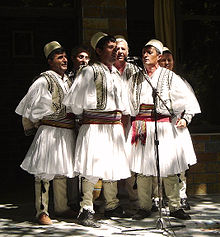Tallava
| Tallava | |
|---|---|
| Stylistic origins | |
| Cultural origins | Romani in Kosovo |
 | ||||
| Music of Albania | ||||
| General topics | ||||
|---|---|---|---|---|
| Genres | ||||
| Media and performance | ||||
|
||||
| Nationalistic and patriotic songs | ||||
|
||||
Tallava or Talava is a music genre originating from Albanian-speaking Roma communities in Kosovo as well as in North Macedonia, with a presence in Albania.[1][2][3] Having originated in the Roma community in Kosovo in the 1990s, it evokes regional Balkan musical styles (e.g., microtones, vocal glissando, and certain musical instruments) and has become popular in Albania and North Macedonia.[4] It is identified as part of the wider pop-folk genre of the Southeastern Europe, which includes Chalga from Bulgaria, Skiladiko from Greece, Manele from Romania and turbo-folk from Serbia.[5]
History
Tallava originated in the 1980s and 1990s within the Albanian-speaking areas of Kosovo region, created by the Romani ethnic minority community.[4] The name is derived from Romani tel o vas, meaning "under the hand", referring to the čoček dance where the hands are waved delicately.[6] Kosovo Albanian refugees of the Kosovo War in North Macedonia had brought their music with them, including Tallava.[7] It has since also been adopted by the non-Albanian-speaking Roma in North Macedonia.[4]
Identity and reputation
Tallava occupies an ambivalent place in popular consciousness; it is both celebrated and vilified by the wider Albanian community. In the minds of many, its Ashkali origins imbue it with a lower-class connotation, and it is often disparaged. However, tallava is extremely popular and considered by many necessary for any party, especially a wedding.[8] Kosovo Roma musician Bajram Kafu Kinolli suggests that it is simple racism that gave tallava its low status: “Bearing in mind that it was the Roma, Ashkali and Egyptians who mostly cultivated tallava and that they are in a crisis in regard to presenting their culture… some people label it as a degradation, especially today when the word ‘tallava’ is a dirty, filthy, and degrading term for anything in Kosovo.”[9]
Style and attributes
Initially, tallava music was performed in cafes, and the def, a kind of tambourine, predominated. In the 1990s, other instruments like drums, bass guitar, guitar, accordion and clarinet were incorporated. Kafu Kinolli sees tallava as distinct from the wider turbo-folk umbrella genre in that whereas a turbo-folk song has a linear structure (e.g., verse-chorus-verse-chorus), tallava songs are longer, more improvisational, and without a definitive structure. However, this improvisational character leads other musicologists, such as Astrit Stafai, to believe that tallava does not constitute a genre in and of itself: “... tallava is an improvisation of a certain moment, for example at a family-related or personal occasion. Tallava has neither a musical form nor development. It just doesn't have the proper concept to be a musical style”.[10]
Popular Tallava Keyboard Players
• Amza Tairov
• Klinton Demirovski
• Xsoundbeatz
• Enes Avdo
• Enis Doctor
• Vedat Haziri
• Brothers Krasniqi
• Sermin Sero
• SkennyBeatz
• Ferdin Tatari
• Visar Japani
• Memi Balija
Popular singers
Albania
- Baba Qel
- Mazlum Shaqiri
- Sulltan Hajolli
- Mandi Nishtulla
- Muharrem Ahmeti
- Marseli
- Altin Shira
- Sinan Hoxha
- Seldi Qualliu
- Mandi Nishtulla
- Vani Gjuzi
- Pandora
- Xhavit Dedej
- Soni Alidemit
Kosovo and North Macedonia
- Daim Lala
- Meda
- Mentor Kurtishi
- Bekim Dehari
- Zyber Avdiu
- Gazmend Rama (Gazi)
- Duli
- Sefë Duraj
- Adem Mehmeti
- Leonora Bahiti
- Shkurte Gashi
- Teuta Selimi
- Avdyl Mziu
- Muhamet Sejdiu
- Linda
- Ylli
- Buqe Rama
- Besim Mahmuti
- Memi
- Antigona Sejdiu
- Amtigona Rrustolli
- Ganimete Asllani
- Adem Ramadani
- Syne Loshi
- Leta (Tallava Music)
- Aferdita Demaku
- Baba celj Djemail
- Ibrahim Ruli Shotano
- Nehat Gasi
- Djemail Gasi
- Cita Zumberi (hajde babo babo )
- Sultan hajoli
See also
References
- ^ Samson, Jim (2013). Music in the Balkans. BRILL. ISBN 978-9004250383.
- ^ Refleksion sociologjik mbi kiçin e muzikës tallava Archived 2015-09-24 at the Wayback Machine
- ^ Gail Warrander and Verena Knaus (2010). Kosovo. BRADT. ISBN 9781841623313.
- ^ a b c Samson 2013, p. 79.
- ^ Natalie Bayer (2009). Crossing Munich. Silke Schreiber. ISBN 978-3-88960-108-7.
Formen wie: tallava in Albanien, chalga in Bulgarien, skiládiko in ... in Rumänien, turbo folk in Serbien usw
- ^ Carol Silverman (24 May 2012). Romani Routes: Cultural Politics and Balkan Music in Diaspora. Oxford University Press. pp. 36–. ISBN 978-0-19-530094-9.
- ^ Samson 2013, p. 77.
- ^ Kika, Ardit. "The Sounds of Tallava". Prishtina Insight. Retrieved 3 September 2019.
- ^ Kika, Ardit. "The Sounds of Tallava". Prishtina Insight. Retrieved 3 September 2019.
- ^ Kika, Ardit. "The Sounds of Tallava". Prishtina Insight. Retrieved 3 September 2019.
Sources
- Samson, Jim (2013). Music in the Balkans. BRILL. pp. 77–79. ISBN 978-90-04-25038-3.
- Refleksion sociologjik mbi kiçin e muzikës tallava
